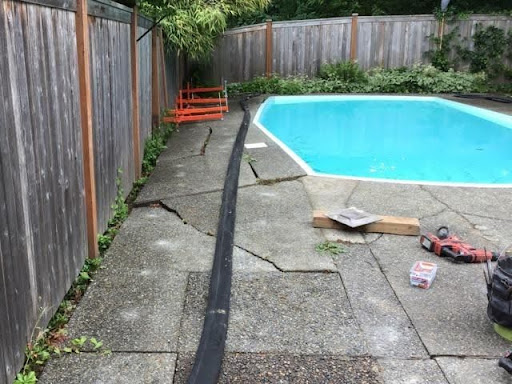Sinking concrete refers to the gradual settling or sinking of concrete surfaces, such as sidewalks, driveways, or patios, due to various factors like soil erosion, poor compaction, or changes in moisture content. In Long Island, Brooklyn, and Queens, sinking concrete is a common issue due to the diverse soil composition in the region, which includes expansive clay soils prone to shrinkage and swelling.
Additionally, the high water table and coastal proximity can contribute to soil instability, exacerbating the problem. As the soil beneath concrete slabs loses support, it leads to uneven settling, causing cracks, gaps, and an uneven surface, impacting the structural integrity and aesthetics of the concrete.
Fortunately, fixing sinking concrete can be complex, but here is a comprehensive guide that will tell you how to address the issue.
Understanding the Issue:
Sinking concrete is a common problem due to soil erosion, poor compaction, or water damage. Before attempting to fix it, it’s crucial to understand the underlying cause.
1. Assess the Damage:
Start by examining the extent of the sinking. Identify the affected areas and measure the depth of the sinking. This will determine the appropriate solution.
2. Identify the Cause:
Understanding why the concrete is sinking is crucial for a lasting fix. Common causes include water drainage, soil compaction problems, or poor initial installation.
3. Plan the Repair:
Based on your assessment, plan the repair strategy. The solution might involve lifting the concrete, stabilizing the soil, or both. Consider factors such as budget, time, and the severity of the damage.
Repair Options:
Mudjacking:
Mudjacking, or slabjacking, is a common method for lifting sunken concrete. It involves injecting a mixture of soil, water, and cement beneath the slab, raising it to its original position. This is effective for small to moderately sized areas. The injected material solidifies and lifts the slab, restoring it to its original position.
Mudjacking is commonly used to address sunken sidewalks, driveways, patios, and other concrete surfaces. It is a cost-effective alternative to removing and replacing the entire concrete slab, saving time and money. Additionally, mudjacking is considered a sustainable approach as it helps minimize waste and environmental impact.
One of the critical advantages of mudjacking is its versatility. It can be used on various surfaces and is suitable for residential and commercial applications. The process is relatively quick, allowing for minimal disruption to daily activities.
However, it’s important to note that the success of mudjacking depends on the underlying cause of the concrete settlement. It may not be suitable for all situations with structural issues or extensive damage to the concrete.
Before opting for mudjacking or any concrete repair method, it’s advisable to consult with professionals who can determine the specific situation and recommend the most appropriate solution based on the root cause of the problem.
5. Polyurethane Foam Injection:
Polyurethane foam injection is a modern and effective solution. The expanding foam lifts the concrete and stabilizes the soil. It’s less invasive than mudjacking and provides long-lasting results.
6. Soil Stabilization:
Addressing soil-related issues is crucial for preventing future sinking. Improve soil compaction and drainage to ensure a stable foundation. This may involve adding gravel, compacting the soil, or installing proper drainage systems.
DIY Repair Steps
1. Gather Materials:
For smaller projects, you can consider a DIY approach. Gather the necessary materials, including concrete mix, a shovel, a leveling compound, and a tamper.
2. Remove Loose Concrete:
Start by removing any loose or damaged concrete. Use a chisel and hammer to break away the unstable sections. Clean the area thoroughly.
3. Leveling Compound:
Apply a leveling compound to even out the surface. This helps create a smooth and level base for the new concrete.
4. Mix and Pour Concrete:
Mix the concrete according to the instructions. Pour it into the prepared area, ensuring it reaches the desired level. Use a trowel to smooth the surface.
5. Allow for Curing:
Give the newly poured concrete sufficient time to cure. Follow the recommended curing period to ensure a strong and durable repair.
Preventive Measures:
1. Improve Drainage:
Ensure proper drainage around the concrete area.
Water seepage can lead to erosion and sinking. Install gutters, downspouts, or French drains to redirect water away from the foundation.
2. Compaction and Grading:
Regularly inspect and address soil compaction issues. Proper soil grading around the concrete can prevent water accumulation and erosion.
Professional Assistance:
For extensive or complex cases, it’s advisable to seek professional help. Before you do anything, consult a foundation repair expert or a structural engineer to assess the situation and consult a reputable concrete repair company for the best action.
Conclusion:
Fixing sinking concrete requires a systematic approach, from understanding the cause to choosing the appropriate repair method. Whether opting for mudjacking, polyurethane foam injection, or a DIY solution, it’s crucial to address the symptoms and the underlying issues. Consult with professionals to provide a thorough and lasting repair if in doubt.
Contact The Mudjacking Contractors. The name you can trust for your Mudjacking job!

